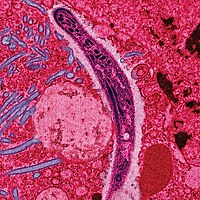
Mitochondrial genome of Helice tientsinensis (Brachyura: Grapsoidea: Varunidae): Gene rearrangements and higher-level phylogeny of the Brachyura.
Sign Up to like & getrecommendations! Published in 2017 at "Gene"
DOI: 10.1016/j.gene.2017.06.036
Abstract: The mitochondrial genome (mt genome) provides important information for understanding molecular evolution and phylogeny. The further understand the molecular evolution and phylogeny of Helice tientsinensis, the complete mt genome was determined. It is 16,212bp long… read more here.
Keywords: helice tientsinensis; tientsinensis; mitochondrial genome; gene ... See more keywords

Evaluation of the diagnostic value of immunoglobulin clonal gene rearrangements in patients with parotid gland MALT lymphoma using BIOMED-2 protocol.
Sign Up to like & getrecommendations! Published in 2018 at "Oral surgery, oral medicine, oral pathology and oral radiology"
DOI: 10.1016/j.oooo.2018.03.005
Abstract: OBJECTIVES The aim of this study was to evaluate the diagnostic value of immunoglobulin (Ig) clonal gene rearrangements for mucosa-associated lymphoid tissue (MALT) lymphoma of the parotid gland. STUDY DESIGN We collected and retrospectively analyzed… read more here.
Keywords: parotid gland; malt lymphoma; clonal gene; gene rearrangements ... See more keywords

Next-generation sequencing of immunoglobulin gene rearrangements for clonality assessment: a technical feasibility study by EuroClonality-NGS
Sign Up to like & getrecommendations! Published in 2019 at "Leukemia"
DOI: 10.1038/s41375-019-0508-7
Abstract: One of the hallmarks of B lymphoid malignancies is a B cell clone characterized by a unique footprint of clonal immunoglobulin (IG) gene rearrangements that serves as a diagnostic marker for clonality assessment. The EuroClonality/BIOMED-2… read more here.
Keywords: euroclonality ngs; feasibility study; clonality assessment; gene ... See more keywords

Gene rearrangements of MLL and RUNX1 sporadically occur in normal CD34+ cells under cytokine stimulation
Sign Up to like & getrecommendations! Published in 2020 at "Cancer Science"
DOI: 10.1111/cas.14392
Abstract: Gene rearrangements of MLL/KMT2A or RUNX1 are the major cause of therapy‐related leukemia. Moreover, MLL rearrangements are the major cause of infant leukemia, and RUNX1 rearrangements are frequently detected in cord blood. These genes are… read more here.
Keywords: cytokine stimulation; rearrangements mll; mll runx1; gene ... See more keywords

Screening for ROS1 gene rearrangements in non‐small‐cell lung cancers using immunohistochemistry with FISH confirmation is an effective method to identify this rare target
Sign Up to like & getrecommendations! Published in 2017 at "Histopathology"
DOI: 10.1111/his.13076
Abstract: To assess the prevalence of ROS1 rearrangements in a retrospective and prospective diagnostic Australian cohort and evaluate the effectiveness of immunohistochemical screening. read more here.
Keywords: screening ros1; ros1 gene; rearrangements non; non small ... See more keywords

Spectrum of kinase gene rearrangements in a large series of paediatric inflammatory myofibroblastic tumours.
Sign Up to like & getrecommendations! Published in 2023 at "Histopathology"
DOI: 10.1111/his.14912
Abstract: INTRODUCTION Inflammatory myofibroblastic tumours (IMTs), being an exceptionally rare category of paediatric neoplasms, often contain druggable gene rearrangements involving tyrosine kinases. METHODS AND RESULTS This study presents a large consecutive series of IMTs which were… read more here.
Keywords: myofibroblastic tumours; series; kinase gene; gene rearrangements ... See more keywords

TCF3 gene rearrangements in pediatric B-cell acute lymphoblastic leukemia-A single center experience.
Sign Up to like & getrecommendations! Published in 2023 at "International journal of laboratory hematology"
DOI: 10.1111/ijlh.14072
Abstract: INTRODUCTION B-cell precursor acute lymphoblastic leukemia (BCP-ALL) is the most common neoplasm in children. One of the long known recurrent rearrangements in BCP-ALL is t(1;19)(q23;p13.3)/TCF3::PBX1. However, other TCF3 gene rearrangements were also described that are… read more here.
Keywords: tcf3; gene rearrangements; lymphoblastic leukemia; acute lymphoblastic ... See more keywords

MYC Gene Rearrangements Are Closely Associated with Poor Survival of Diffuse Large B Cell Lymphoma with Hepatitis B Virus Infection
Sign Up to like & getrecommendations! Published in 2017 at "BioMed Research International"
DOI: 10.1155/2017/1967648
Abstract: The aim of this study was to identify clinical adverse prognostic factors affecting overall survival (OS) of diffuse large B cell (DLBCL) patients with hepatitis B virus (HBV) infection. In this study, 30 DLBCL patients… read more here.
Keywords: infection; group; survival; hbv infection ... See more keywords

Capture Sequencing Is a Useful Method for Comprehensive Clonality Analysis Based on Ig/TCR Gene Rearrangements in Acute Lymphoblastic Leukemia
Sign Up to like & getrecommendations! Published in 2018 at "Blood"
DOI: 10.1182/blood-2018-99-115624
Abstract: Introduction Immunoglobulin (Ig)/ T-cell receptor (TCR) gene rearrangements are the most widely used clonal marker to detect residual leukemic cells in patients with Acute Lymphoblastic Leukemia (ALL). Ig/TCR gene rearrangements based molecular minimum residual disease… read more here.
Keywords: capture sequencing; mrd; gene rearrangements; tcr gene ... See more keywords

Unmet needs in the treatment of intrahepatic cholangiocarcinoma harboring FGFR2 gene rearrangements.
Sign Up to like & getrecommendations! Published in 2022 at "Future oncology"
DOI: 10.2217/fon-2021-1089
Abstract: Intrahepatic cholangiocarcinoma, a malignancy of the intrahepatic bile ducts, is the second most common primary liver malignancy and has been rising in incidence over the past several decades. Given its poor prognosis and diagnosis at… read more here.
Keywords: intrahepatic cholangiocarcinoma; cholangiocarcinoma; fgfr2 gene; gene rearrangements ... See more keywords

The Histone Deacetylase Inhibitor I1 Induces Differentiation of Acute Leukemia Cells With MLL Gene Rearrangements via Epigenetic Modification
Sign Up to like & getrecommendations! Published in 2022 at "Frontiers in Pharmacology"
DOI: 10.3389/fphar.2022.876076
Abstract: Acute leukemia (AL) is characterized by excessive proliferation and impaired differentiation of leukemic cells. AL includes acute myeloid leukemia (AML) and acute lymphoblastic leukemia (ALL). Previous studies have demonstrated that about 10% of AML and… read more here.
Keywords: cell; molm thp; leukemia; acute leukemia ... See more keywords